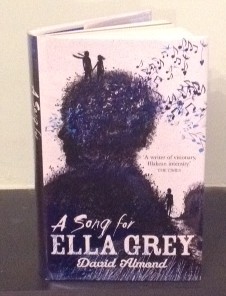Inspiring Young Readers
 posted on 24 Nov 2015
posted on 24 Nov 2015
A Song For Ella Grey by David Almond
David Almond is a creator of modern myths – perhaps most famously with his magnificent Skellig which has become a classic of children’s literature. His writing is lyrical and hypnotic, a style that does not patronise his target audience and demands effort from his readers.
In A Song For Ella Grey Almond explicitly deals in classical mythology, rewriting the story of Orpheus and Eurydice for a modern audience and setting it in the North East. Ella Grey, a beautiful dreamer, and her best friend Claire – who tells this story - are part of a group of friends on the threshold of adulthood longing for excitement and meaning in their lives. As they approach the end of their school life the friends go on an Easter holiday on the Northumberland coast – but without Ella whose adoptive parents refuse to let her travel with them. While camping on the beach they encounter the unearthly and mysteriously magnetic Orpheus who, through his music, has the power to enchant all living things. Claire enables Ella to experience Orpheus’s music through using her mobile phone and an immediate connection is made between the two that will end in tragic and remarkable ways.
At this point the original story of Orpheus and Eurydice begins to play out. It’s not necessary to know the original myth to appreciate the way the story unfolds but I think Almond’s treatment makes more sense if you do know how the classical tale develops. I don’t want to spell that story out because it may spoil it for those who want to read the book but it is intense and even more so when seen through the eyes of the emotional Claire.
Almond’s intention is to try and create a recognisable world in which the story takes place – the evocation of the landscape, the school classroom and the use of colloquial Tyneside accents help with this - but the world he creates is never intended to be a realistic representation. The characters of Ella and Orpheus are not fully rounded, three-dimensional people – their unfathomable, supernatural love for each other is the heady stuff of myth – and it is only Claire’s unswerving love and loyalty to Ella that provides us with an anchor of stability in an otherwise ethereal world of over-wrought emotions .
Almond’s language and written style become increasingly mystical and visionary as the book moves forward. He pulls out all the tricks – Orpheus’s trip to the underworld is actually printed as white on a black background to emphasise the darkness of the descent to Hell and the death of Orpheus is frantic and blood-thirsty, reflecting the original story of the way the Maenads exact their punishment.
This is an extraordinary book for a teenage audience and it is uncompromising in how it tells its tale. But, in reality, Almond is not really writing books for teenagers – he’s writing books for readers of all ages and challenging everyone to engage with some of the most elemental and fundamental ideas.
Terry Potter
November 2015